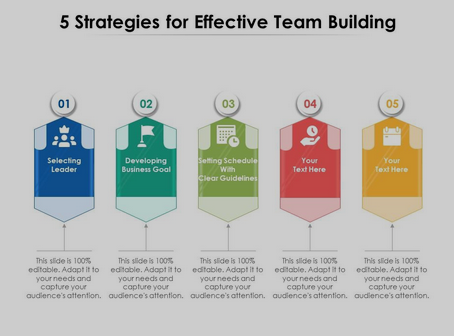Effective team building is crucial for creating a positive and collaborative work environment. Here are some strategies to build and strengthen teams:

Clearly Define Team Goals:
Ensure that the team understands its purpose and overarching goals. Clearly defined objectives provide a common focus and help team members understand their individual contributions to the team’s success.
Encourage Open Communication:
Foster an environment where team members feel comfortable expressing their ideas, concerns, and opinions. Encourage open dialogue during meetings, and establish channels for feedback to promote transparency and trust.
Promote Team Bonding Activities:
Plan team-building activities that allow members to interact in a relaxed and informal setting. This could include social events, off-site retreats, or team-building exercises. These activities help build rapport and strengthen interpersonal relationships.
Establish Team Norms:
Collaboratively set expectations for communication, decision-making, and conflict resolution. Establishing team norms helps create a shared understanding of how the team will operate and promotes a positive working environment.
Recognize and Celebrate Achievements:
Acknowledge and celebrate both individual and team achievements. Recognition reinforces positive behavior and motivates team members to continue contributing to the team’s success.
Promote Inclusivity:
Ensure that all team members feel included and valued. Address any signs of exclusion or cliques within the team. Promote diversity and create an environment where everyone’s perspectives are respected.
Encourage Skill Diversity:
Recognize and leverage the diverse skills and strengths of team members. Encourage collaboration by assigning tasks that align with individual strengths, fostering a sense of value and contribution.
Rotate Leadership Roles:
Provide opportunities for different team members to take on leadership roles or lead specific projects. This not only develops leadership skills but also ensures that team members feel empowered and engaged in their work.
Invest in Professional Development:
Support the ongoing learning and development of team members. Offer training opportunities, workshops, or courses that align with the team’s goals and individual career aspirations.
Establish a Team Charter:
Create a team charter that outlines the team’s purpose, goals, values, and operating norms. This document serves as a reference point for team members and helps maintain focus on shared objectives.
Facilitate Team-Building Workshops:
Conduct periodic team-building workshops or training sessions. These sessions can address specific challenges, enhance communication skills, and build a deeper understanding of team dynamics.
Encourage Cross-Functional Collaboration:
Foster collaboration across different departments or functions within the organization. Cross-functional collaboration introduces diverse perspectives and promotes a holistic approach to problem-solving.
Provide Resources and Support:
Ensure that the team has the necessary resources, tools, and support to accomplish its goals. Lack of resources or support can hinder team performance and morale.
Regular Check-ins:
Schedule regular check-in meetings to assess progress, address concerns, and provide feedback. Regular communication helps prevent misunderstandings and keeps everyone aligned with the team’s objectives.
Model Positive Behavior:
Leadership should model the behavior they expect from the team. Demonstrating positive communication, collaboration, and a strong work ethic sets a standard for the entire team.
Effective team building is an ongoing process that requires commitment and effort from both leaders and team members. By implementing these strategies, organizations can create a cohesive and high-performing team that is better equipped to tackle challenges and achieve its objectives.
